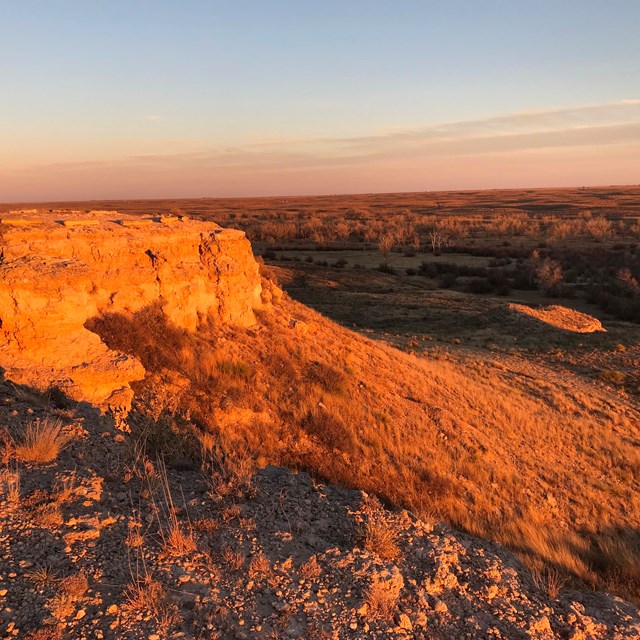Autograph Rock. 623 words.
This graphic panel sits facing a wide rocky bluff. The lower part is solid rock with horizontal layers. Closer to the top are large boulders embedded in soil. At the base of the bluff and on either side is grassy meadow with scattered trees.
The background of this panel has a photograph looking to the right along the base of the bluff. On top of the photo are small drawings populating the scene as it might have been historically. Along the far right are several covered wagons. Near the middle is a campfire with two iron pots suspended from a makeshift spit. Just to the left three men sit on blankets with several metal bowls. Two men sit near a bedroll at lower right. Another man with a rifle sits on horseback closer to the bluff.
Text on the panel is in both English and Spanish. At upper left it reads, "Hundreds of historic and prehistoric inscriptions make Autograph Rock an irreplaceable record of use. The sheltering stone walls, reliable water, and ample forage made this area a popular camp for travelers crossing this semi-arid landscape. Many carved the surrounding sandstone bluffs during their visit. The earliest markings are groups of parallel lines thought to have been ground into the sandstone by Indigenous peoples. Similar carvings are found associated with hunter-gatherer camp deposits in the area dating back centuries. In the 1800s, Mexican and American traders etched names and dates while traveling back and forth along the Cimarron Route of the Santa Fe Trail. US Army soldiers assigned to protect wagon trains or deployed to western forts engraved the names of their military units here. Help protect this private land and its resources by not marking or climbing on the rock."
Down the right side of the panel are small photographs of some of the carvings. At upper left is a carving on orange and tan rock that reads, "F.B. Delgado." Below is an oval portrait of a man in a suit and vest with thick dark hair and mustache. The caption reads, "Felipe B. Delgado, circa 1842 - 1908, was a trader and a member of a prominent Santa Fe family. Educated in St. Louis, he owned a mercantile business that freighted goods along the Santa Fe Trail."
Below that is a photo of brown and tan rock with deep horizontal grooves. Carved into the rock is a series of diagonal parallel lines crossed with a few deeper vertical lines. The caption reads, "Several groups of parallel lines engraved in the stone, which are thought to predate the Santa Fe Trail, show evidence of early use of the site."
At the upper right is a photo of an engraving on multicolored rock of grays and oranges. It reads, "S. Brown. C. F. 3rd I. 1859." The caption reads, "S. Brown was an infantry soldier in the US Army, which patrolled the Trail. While movies and novels have glorified the cavalry, infantry troops formed the backbone of the frontier Army."
Below that is a carving on light tan and gray rock which reads, "R. Beatty, Sept 20, 1865, Dayton, Ohio." The caption reads, "Robert Beatty, from Dayton, Ohio, was hired in 1865 to help drive more than 1,000 head of cattle from Kansas to New Mexico."
Across the top of the panel is a black bar. At the left end text reads "Autograph Rock." At the right end is a logo and text for Santa Fe National Historic Trail. Other text reads, "Santa Fe Trail Association, Cimarron Heritage Center, National Park Service."
In the bottom righthand corner of the panel is a QR code and the Audio Description symbol. Text reads, "For audio description of this wayside visit go.nps.gov/AutographRock."
End of Description.


